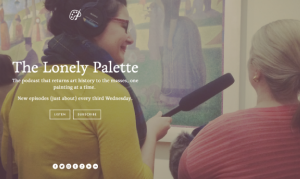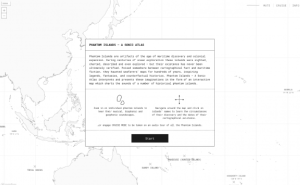|
Help |
Site Map
|
 |
|
THE LONELY PALETTE
|
ARTS |
|
|
|
The Lonely Palette is a new podcast that may appeal to readers interested in learning a bit of art history, one famous artwork at a time. Hosted by "art historian turned finance administrator turned independent radio producer" Tamar Avishai, each episode of the Lonely Palette is centered around a specific artwork, including a number of works held at the Museum of Fine Arts, Boston (where Avishai works as an adjunct lecturer). Avishai opens each episode by interviewing museum visitors about the featured work of art, providing listeners with a rich variety of perspectives. Next, Avishai shares her own insights about the selected work of art and its significance. In doing so, Avishai hopes to make art and art history accessible to everyone. Featured artworks in this series include Yoko Ono's Cut Piece (1964); JMW Turner's The Slave Ship; Paul Gauguin'sWhere Do We Come From? Where Are We? Where Are We Going?, and Jackson Pollock's Number 10, to name just a few. [MMB]
|
|
|
|
|
 |
|
PHANTOM ISLANDS - A SONIC ATLAS
|
SOCIAL STUDIES |
|
|
|
The term "phantom island" refers to an island that appeared on historical maps (sometimes for many years) even though it doesn't exist. Most phantom islands emerged from the era of European sea exploration and colonization. Phantom Islands - A Sonic Atlas is a project by sound artist Andrew Pekler that pairs original sound recordings with 27 phantom islands. This project was created for the French Museum Jeu de Paume for its exhibit "Fourth Worlds: Imaginary Ethnographies in Sound and Music." Each of these islands is placed according to its coordinates on historical maps. Visitors can explore these individual islands by either taking a "cruise" or by navigating with their cursor. As one visits each island, they will hear a unique soundscape and can read about the island's history, including the date of the island's first and last appearance in print. The earliest phantom island included on this journey is the island of Taprobana, which appeared in Ptolemy's Geography in 150 CE. As the accompanying description on this atlas notes, "The inhabitants of Taprobana are at various times described as possessing forked tongues, being able to navigate the flight of birds, and having one giant foot from which they shade themselves from the sun." Other islands included in this project include Frisland, Fonseca, and Bermeja. [MMB]
|
|
|
|
|
 |
|
BRITISH LIBRARY: ENDANGERED ARCHIVES BLOG
|
SOCIAL STUDIES |
|
|
|
Launched in 2004, the British Library's Endangered Archives Program (EAP) supports the preservation and digitization of archives around the globe. As of this write-up, the EAP has "supported over 300 projects in 90 countries worldwide, resulting in over 6.5 million images and 25 thousand soundtracks being preserved." For visitors interested in learning more about the rich material that has been digitized through the EAP, the Endangered Archives blog highlights some of these collections. For instance, one recent post by EAP curator Jody Butterworth highlights correspondence about the Mabeoena Football Club, which was founded in 1932 in Lesotho. These letters are part of the Matsieng Royal Archives in Lesotho. In another recent post, Nasir Javaid of the Mushfiq Khwaja Trust for the Advancement of Knowledge and Culture in Karachi, Pakistan writes about the archive's collection of Urdu periodicals. As Javaid writes, " Urdu journals played a significant role in the development of Urdu literature, especially fiction, religion, history, poetry and culture of the South Asian region as a whole, particularly in Pakistan and India. If someone wants to write on the development of fiction or religious literature, they should refer back to these rare periodicals." Each blog post is accompanied by images of select archival material from the highlighted collection. [MMB]
|
|
|
|
|
 |
|
COLOR IN A CAN: EARLY MARKETING OF PAINT IN AMERICA
|
SOCIAL STUDIES |
|
|
|
Color in a Can was shown on site at the Athenaeum of Philadelphia from January 15 - April 22, 2016. This web version provides additional information that was not included in the original exhibition, including installation views of the show. The 64 advertising signs from the late nineteenth and early twentieth centuries in Color in a Can represent only a small portion of the historical paint research collection at the Athenaeum, built primarily by the efforts of former Athenaeum Executive Director Dr. Roger W. Moss, who is known for his extensive research and writing on the study of historic paint in America. Color in a Can documents the rise of pre-mixed house paints in standardized colors, sold in metal cans with resealable lids, that occurred in the U.S. after the Civil War. Some company names in the exhibition are still common today. For example, Pittsburgh Plate Glass is a currently operated company, while other companies have been bought out or gone out of business. The advertising also promotes asbestos and lead paints that we know to be dangerous today. Many of the items are graphically interesting, such as the Patton Paint Company's rotating wheel of sun-proof paint colors, made to be displayed in a paint store. [DS]
|
|
|
|
|
The Internet Scout Research Group, located in the Computer Sciences Department at the University of Wisconsin-Madison, provides Internet publications and software to the research and education communities under grants from the National Science Foundation, the Andrew W. Mellon foundation, and other philanthropic organizations. Users may make and distribute verbatim copies of any of Internet Scout's publications or web content, provided this paragraph, including the above copyright notice, is preserved on all copies. Pages: 1 · 2
Culture and Arts, Relationships and Going Places, Art and Museums, History, Culture Watch, Learning, Senior Women Web, Articles, Sightings, What's New
|
|












